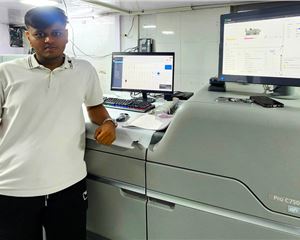Finding a niche in speciality BOPP films to build a global business
As competition grows, the ideal business model for a BOPP film manufacturer is to identify niche products and then look to specialise in them, says Pankaj Poddar, CEO, Cosmo Films. He explains to Dibyajyoti Sarma how Cosmo Films does it
21 Mar 2016 | By Dibyajyoti Sarma
According to latest market research reports, BOPP film industry is poised to grow well, riding on the growth in modern retail and growing consumption of packaged food and beverages globally.
According to Pankaj Poddar, CEO, Cosmo Films, the company is anticipating a strong demand for BOPP films in the coming years, especially from the FMCG sector. “This has prompted us to expand our BOPP production capacity,” he says.
The bi-axially oriented polypropylene (BOPP) films, which offer high strength, elasticity, high barrier properties, resistance to various corrosive environments, and inertness go into making of flexible food packaging, adhesive tapes, labels and lamination applications, among others.
Poddar says industry estimates the consumption of BOPP films to be close to 8 million tonnes by 2016, growing at 4-5% annually.
“Along with the growth of the industry, the number of BOPP film manufacturers is also increasing at a similar pace, thus, making the competitive landscape tougher and tougher by the year,” Poddar says. “One way to survive in this tough competitive landscape is to identify niche products and then look to specialise in them.”
Poddar says finding this niche involves both external and internal factors.
“It begins with an external influence - an unmet customer need for which there are not many solution providers, thus making it a niche segment,” he explains.
Then internally, at the manufacturing level, the required solution must go through tests for its functionality and feasibility. Once a niche has been identified and defined, the company would channelise resources to facilitate internal preferential treatment.
“This includes R&D focus to develop the complete product lineup, separate production lines designation, priority production planning and dispatch, differentiated pre- and after-sales service, and good marketing and PR support,” says Poddar.
Once the solution is ready, the company would test market it in the identified market. Then, slowly, it would expand its reach to other markets with similar needs. “The company may also look at getting into exclusive arrangements with its supply chain partners for these products,” he adds.
Poddar says that since its establishment in 1981, New Delhi-headquartered Cosmo Films has built itself to be the largest exporter of BOPP films from India by identifying niche segments and then fulfilling the market needs with appropriate solutions.
Keeping up with it, the company is setting up a new BOPP line by early 2017, which will increase the company’s annual BOPP production capacity from 140,000 to 200,000 metric tonnes. The new production line is at the Karjan plant site near Vadodara, an existing facility with the company, which already houses BOPP lines, extrusion coating and chemical coating lines and a metalliser.
Cosmo’s speciality products
There are three major segments in which Cosmo Films specialises – packaging applications, labeling and lamination. “Within these three categories, we manufacture different kind of speciality films,” he says.
Speciality films for packaging applications
The company manufactures different kinds of barrier films used in different food packaging, these include:
High moisture barrier films: These are metallised films used for sandwich lamination in shampoo sachets, dry milk powder, powdered drinks sachets/packs and snack foods, where loss of moisture is a concern.

Aroma barrier films: These are transparent barrier films typically used for coffee/tea, spices, chewing gum and perfume boxes overwrapping.
High oxygen barrier films: These films have both excellent oxygen and gas barrier properties and are used for packaging of cream biscuits, chocolates, chips and snacks.
Anti-fog films: These transparent films extend the shelf life of fresh-cut vegetables/fruits and meat that need to be refrigerated in sub-zero temperatures by additional 4 to 7 days.
Other speciality films for packaging applications include:
Films for cold seal application: These are used for packs where heat sealing is bound to interfere with the food content inside the pack. This includes chocolates, ice creams, etc. The film has its surface modified for the cold seal glue (HMPSA/solution acrylic PSA) application.
Films with low SIT: These are used for printed pouches used in food packs and cigarette overwraps requiring sealing at low temperatures and high speed machines. The film’s sealing temperature can go down up to 75 degrees and therefore, it has broader heat seal range.

Films with stable slip: These are again used for food packaging done on VFFS/HFFS machines, where consistent COF is (Kinetic: 0.25 - 0.35) is a pre-requisite.
“Tight cigarette overwraps is a speciality at the company though we do all kind of overwraps. The film with excellent transparency and clarity and high shrinkage attributes develops no wrinkles while packing. It runs well on high-speed machines,” Poddar explains.
Speciality films for labeling
Labels face stock films: Label face stock films available in transparent, white and metalised varieties go into making pressure-sensitive labels largely for home and personal care categories. The films are compatible with UV, water-based and solvent-based ink systems and display spectacular print performance across wide variety of printing processes. The films also have high stiffness for conversion and dispensing operations.
Direct thermal printable (DTP) films: These films are used for applications such as information (airport baggage tags), track and trace labeling, and POS weight and price labeling. These are top-coated films which support variable printing. The films with excellent paper like finish have a proprietary coating, which enables dark printing or image/impression formation upon coming in contact with the print head of the thermal printer. The film offers good scuff and water resistance.

Synthetic paper: The film is used for replacing paper in applications where non-tear ability and durability/weather resistance is desired. This includes applications like menu cards, visiting cards, garment tags, children books, maps, calendars, etc. The film with excellent opacity and whiteness supports all kinds of printing with a coated version.
Speciality films for lamination
“We sell our premium lamination films under the Luxotique brand and the range comprises velvet, scuff-free matte, silky matte, silver, digital films, insulation, and encapsulation films,” says Poddar.
Except insulation and encapsulation, all the other films go into luxury packaging applications. The company also does extrusion coating on PET and nylon films, apart from BOPP films.

Luxotique scuff-free matte: Unlike traditional matte film, this film provides excellent scuff resistance to scuff marks, which can develop during production, transportation and handling of the pack. The matte surface is also ideal for post-laminating procedures such as UV spot coating, hot-foil stamping, embossing, etc.
Luxotique silky matte: The film neither gives a natural matte finish nor provides a complete glossy look, but a combination of both. Due to its rich silky finish, it provides excellent aesthetic appeal to the prints. It goes for laminating cartons, calendars, coffee table books, mostly in the luxury packaging segment.
Luxotique velvet: As the name indicates, the film has been designed to lend rich velvet finish to the printed surface. The film finds its way into premium/luxury packs.
Luxotique silver: This silver film has been designed for lamination with paper and then goes for offset printing for carton and decorative lamination. Silver background provides rich aesthetic appeal & top printable surface provides excellent ink adhesion on prints. On perfume cartons etc., the film also yields barrier properties.
Luxotique digital lamination films: Regular thermal laminating films do not give adequate bonding with digital prints. “Our hi-tac digital films are specially designed for digital print finishing. They are available in both gloss and matte appearances,” Poddar says.

Luxotique insulation films: This metallised film is used for thermal laminating with EPS (Expanded Polystrene) sheets for insulation in building construction. Metalised film helps EPS to withstand the abuse of thermal cycling and assuring long-term performance. Laminated EPS further enhances weather ability and helps mitigate trapping of moisture within wall and roof assemblies. Laminated EPS sheets are light in weight, cost effective and save energy during heating and cooling.
Luxotique encapsulation films: These are premium polyester films used for loyalty/gift cards, ID cards, postcards and applications requiring excellent flatness. “These film rolls come mapped to each other for two-sided lamination and provide excellent clarity and durability to the cards,” says Poddar.












 See All
See All